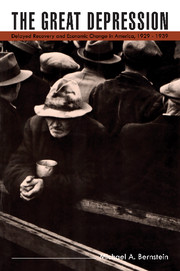Book contents
- Frontmatter
- Contents
- List of tables
- List of figures
- Editors' preface
- Preface
- Introduction: The puzzle of the 1930s
- 1 Long-term economic growth and the problem of recovery in the United States, 1929–39
- 2 The transformation of American industry in the interwar period
- 3 A reassessment of investment failure in the interwar economy
- 4 Technical change during the interwar years
- 5 The effective demand problem of the interwar period. I: Cyclical and structural unemployment
- 6 The effective demand problem of the interwar period. II: Cyclical and secular changes in final demand
- 7 New Deal economic policy and the problem of recovery
- 8 Contemporary economic problems in historical perspective
- Bibliography
- Index
3 - A reassessment of investment failure in the interwar economy
Published online by Cambridge University Press: 06 July 2010
- Frontmatter
- Contents
- List of tables
- List of figures
- Editors' preface
- Preface
- Introduction: The puzzle of the 1930s
- 1 Long-term economic growth and the problem of recovery in the United States, 1929–39
- 2 The transformation of American industry in the interwar period
- 3 A reassessment of investment failure in the interwar economy
- 4 Technical change during the interwar years
- 5 The effective demand problem of the interwar period. I: Cyclical and structural unemployment
- 6 The effective demand problem of the interwar period. II: Cyclical and secular changes in final demand
- 7 New Deal economic policy and the problem of recovery
- 8 Contemporary economic problems in historical perspective
- Bibliography
- Index
Summary
While the profits of stock are high, men will have a motive to accumulate.
– David RicardoA radical shift in the industrial composition of final demand played an important role in delaying a complete recovery from the trough of 1932. This shift in the composition of demand made full employment virtually impossible to achieve after the crash of 1929. Complete recovery required a mass of interrelated new techniques and human and physical capital that, in the timid financial environment prevailing after the crash (and given the uncertainties of the New Deal), could not be organized on the necessary scale by private investment markets.
Investment behavior has been the least examined aspect of the depression, yet it holds the key to understanding cyclical instability. The persistent currency of the “overproduction” (or its mirror image, “underconsumption”) theory of the Great Depression is based on the idea that massive overaccumulation of output in the late 1920s left American industry saddled with enormous inventories that depressed investment for almost a decade below its full-employment level. Although this argument may have some legitimacy for the agricultural sector, it is not supported by the limited available evidence on inventories in major industries.
An inventory-based view of the business cycle also suffers from theoretical inadequacies. One problem concerns the model's characterization of the relevant planning horizon for investment decisions. The model implies that the horizon is relatively short, with modifications in expenditure decisions quickly and easily made.
- Type
- Chapter
- Information
- The Great DepressionDelayed Recovery and Economic Change in America, 1929–1939, pp. 103 - 120Publisher: Cambridge University PressPrint publication year: 1987

